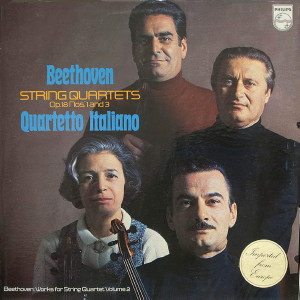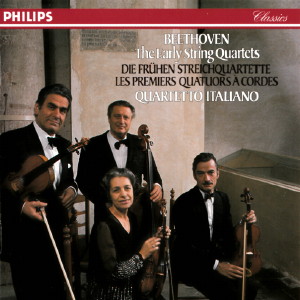 |
|
Philips
- 1 LP - 6500 181 - (p) 1972
|
 |
| Philips
- 3 CDs - 420 046-2 - (c) 1989 |
|
| Ludwig van
Beethoven (1770-1827) |
|
|
|
|
|
|
|
| String
Quartet No. 3 in D major, Op. 18
No. 3 |
|
26' 08" |
|
| -
Allegro |
8' 04" |
|
|
| -
Andante con moto |
8' 27" |
|
|
| -
Allegro |
3' 01" |
|
|
| -
Presto |
6' 36" |
|
|
|
|
|
|
| String
Quartet No. 1 in F major, Op. 18 No. 1 |
|
28' 05" |
|
-
Allegro con brio
|
8' 51" |
|
|
-
Adagio affettuoso ed
appassionato
|
9' 25" |
|
|
| -
Scherzo (Allegro molto) |
3' 22" |
|
|
| -
Allegro |
6' 27" |
|
|
|
|
|
|
QUARTETTO ITALIANO
- Paolo Borciani, Elisa Pegreffi, violino
- Piero Farulli,
viola
- Franco Rossi, violoncello
|
|
|
|
|
|
Luogo e data
di registrazione |
|
La
Salle des Remparts,
La Tour-de-Peilz (Svizzera)
- 13-24
gennaio 1972 |
|
|
Registrazione: live
/ studio |
|
studio |
|
|
Producer / Engineer |
|
Vittorio
Negri | Tony
Buczynski |
|
|
Prima Edizione LP |
|
Philips | 6500
181
| 1
LP | (p) 1972
|
|
|
Prima Edizione CD |
|
Philips | 420 046-2 | 3
CDs - 54'
02"
- 47'
25"
- 57'
28"
- (1*,
1-4; 2°, 1-4) | (c)
1989 | ADD
|
|
|
Note |
|
L'edizione
in CD contiene anche i
Quartetti Op. 18
nn. 2,
4, 5
e 6.
|
|
|
|
|
Beethoven
started composing string
quartets relatively
late, around 1798.
Possibly he wanted first
ro reach a certain
degree of maturity in
his studies of
counterpoint which he
had been following since
1793 with Haydn and
Schenk, and since 1794
with Albrechtsberger
and Salieri. Evidently
he regarded as
essential a command
of polyphonic style,
fugue, canon, and
part-writing. At any
rate in 1795 he
rejected a
commission for a
string quartet by
Count Apponyi (it is
generally believed
that the String
Trio, Op. 3 and the
String Quintet, Op.
4 were abortive
attempts to fulfil
this commission, but
in fact the trio was
written long before
Apponyi's request).
When
working in a new
field it was
natural for
Beethoven to
adhere to
established
patterns. There is
surely more than
superficial
significance in
the fact that he
began with a
series of six
quartets, such as
Mozart had
produced in 1785
and Haydn in 1790.
But as well as
these two masters
the influence of
his own previous
compositions is
also clear. A. B.
Marx, writing
around the middle
of last century,
felt that the
difference between
the quartets on
this record could
be expressed in a
simple formula:
more Beethoven
than quartet in
the D major (No.
3), more quartet
than Beethoven in
the F major (No.
1). There are
indeed clear
differences in
technique of
composition, but
in fact both works
bear a throughly
Beethovian
stamp. It has in
ny case been
shown that the
numbering of
these two works
does not
correspond to
the order of
writing. The D
major Quartet
was completed
first (and is
therefore
presented first
on this
recording) and
it was
apparently
Beethoven's
violinist friend
Schuppanzigh who
advised him that
the later F
major Quartet
would make a
more effective
opening to the
series.
String
Quartet in D,
Op. 18 No. 3
Right
at the start
of the D major
Quartet (No.
3) one is still
very aware of
the division
of the parts
into melodic
and
accompanying
lines. By
comparison
with the often
dominant first
violin part
the other
instruments or
combinations
of instruments
are given
relatively
little
prominence. In
this quartet,
unlike the F
major, the
cello in
particular
takes very
little part in
the thematic
activity. The
normal calm
centre of a
Beethoven
quartet is
occupied here
by the Andante
con moto
of the second
movement,
whose
exceptional
lenght has
been remarked
on by many
critics. The
typical
Beethoven is
certainly in
evidence in
the
scherzo-like Allegro,
which has much
in common with
the scherzo of
the F major
Quartet. This
type of
movement was
to be among
the first to
be fully
developed by
Beethoven. But
he does not
seem to be
completely in
his element
until the
finale, which
clearly stands
apart from the
other
movements. The
sketches
reveal that
Beethoven
spent much time
on it. It is
borne along by
the freshness
and verve of
its writing
which gives
greater
prominence ti
fugal and
canonic
writing.
String
Quartet in G,
Op. 18 No. 1
The
F major
Quartet (No.
1) opens with
an unusually
potent idea of
crucial
importance.
This theme
offers wide
scope for
development
and brings
fresh delight
with each
repetition,
whether in its
original form
or in one of
its variants
with modified
endings. This
is the
foundation for
the superb
thematic work
which was
later to find
a lasting
place in works
like the Fifth
and Sixth
Symphonies.
After
this an
effective
contrast is
provided by
the Adagio
affettuoso ed
appassionato,
a movement of
indescrihable
beauty
and profound
intensity,
whose
similarity to
the Largo
of the D major
Piano Sonata,
Op. 10 No. 3
has often been
noted. The
opening is an
original
stroke, with
its restrained
chords moving
at a very
leisurely pace
and acting as
more than mere
accompaniment
to the soaring
cantilena
of the first
violin entry.
Beethoven is
said to have
been thinking
here of the
tomb scene
from "Romeo
and Juliet."
The scherzo,
one of the
finest of its
kind in
Beethoven's
output,
develops a
lively
dialogue
between the
instruments
with rapid and
starling
dynamie
changes, from
fortissimo
to
triple piano.
In the finale,
the very
diversity of
the material
has prevented
the movement's
unqualified
acceptance;
the American
Beethoven sholar,
Joseph
Kerman, for
instance,
found it
disappointing
after the
previous
movements and
remarked that
Beethoven's
battle for the
finale was yet
to come.
Concerning
an earlier
version of
this F major
Quartet
Beethoven
wrote to his
friend Amenda
that he should
not pass on
the copy he
had received
as he
(Beethoven)
had revised
the work,
"having only
recently
learnt how to
write
quartets."
Beethoven's
comments on
the poor
engraving of
the first
edition are
typically
pithy: "Herr
Mollo has just
brought out my
quartets full
of errors
great and
small; they
are teeming
with mistakes
ad
infinitum
like
fish in the
sea. Questo
è un piacere
per un autore
- I really
call that
engraving: my
skin is
engraved all
over with
scratches at
the thought of
the way my
works have
been presented."
Dr.
Hans Schmidt
|
|
|